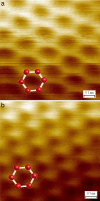High-resolution scanning tunneling microscopy imaging of mesoscopic graphene sheets on an insulating surface
- PMID: 17517635
- PMCID: PMC1874226
- DOI: 10.1073/pnas.0703337104
High-resolution scanning tunneling microscopy imaging of mesoscopic graphene sheets on an insulating surface
Abstract
We present scanning tunneling microscopy (STM) images of single-layer graphene crystals examined under ultrahigh vacuum conditions. The samples, with lateral dimensions on the micrometer scale, were prepared on a silicon dioxide surface by direct exfoliation of crystalline graphite. The single-layer films were identified by using Raman spectroscopy. Topographic images of single-layer samples display the honeycomb structure expected for the full hexagonal symmetry of an isolated graphene monolayer. The absence of observable defects in the STM images is indicative of the high quality of these films. Crystals composed of a few layers of graphene also were examined. They exhibited dramatically different STM topography, displaying the reduced threefold symmetry characteristic of the surface of bulk graphite.
Conflict of interest statement
The authors declare no conflict of interest.
Figures




References
-
- Novoselov KS, Geim AK, Morozov SV, Jiang D, Zhang Y, Dubonos SV, Grigorieva IV, Firsov AA. Science. 2004;306:666–669. - PubMed
-
- Heersche HB, Jarillo-Herrero P, Oostinga JB, Vandersypen LMK, Morpurgo AF. Nature. 2007;446:56–59. - PubMed
-
- Zhang Y, Jiang Z, Small JP, Purewal MS, Tan YW, Fazlollahi M, Chudow JD, Jaszczak JA, Stormer HL, Kim P. Phys Rev Lett. 2006;96:136806. - PubMed
-
- Zhang YB, Tan YW, Stormer HL, Kim P. Nature. 2005;438:201–204. - PubMed
-
- Novoselov KS, Geim AK, Morozov SV, Jiang D, Katsnelson MI, Grigorieva IV, Dubonos SV, Firsov AA. Nature. 2005;438:197–200. - PubMed
LinkOut - more resources
Full Text Sources
Other Literature Sources

